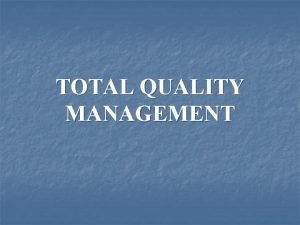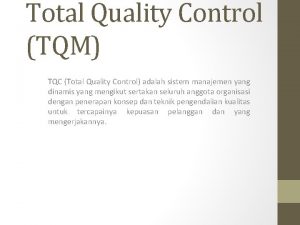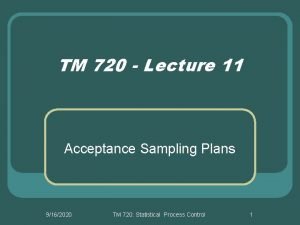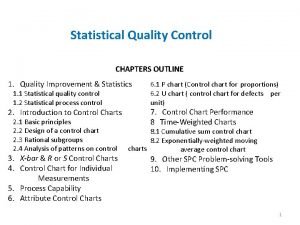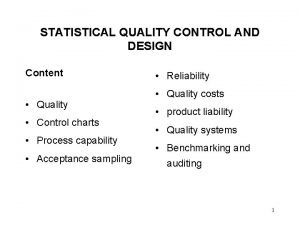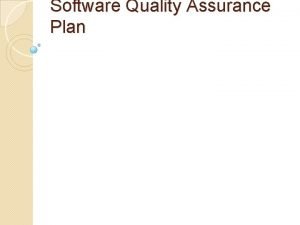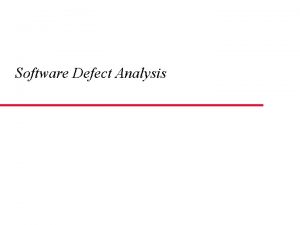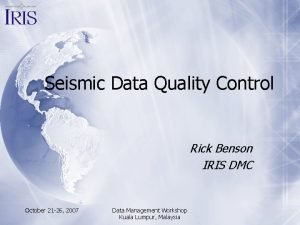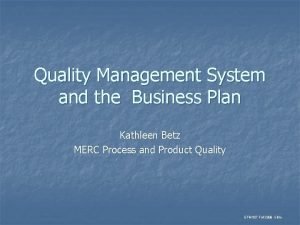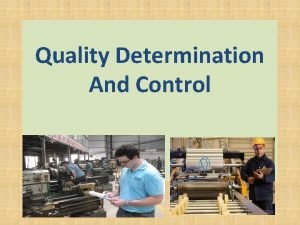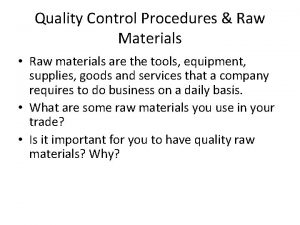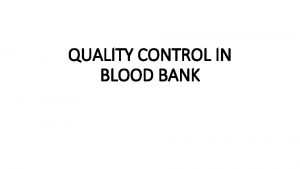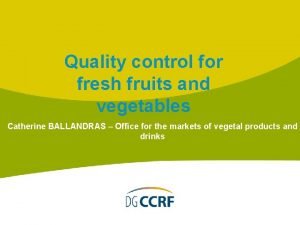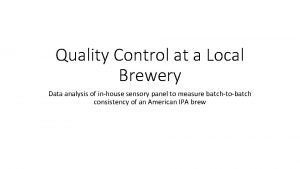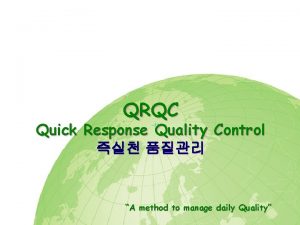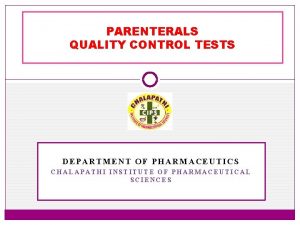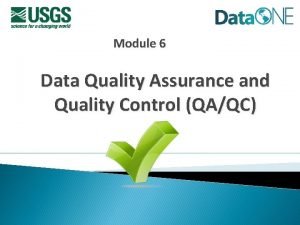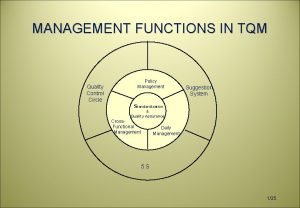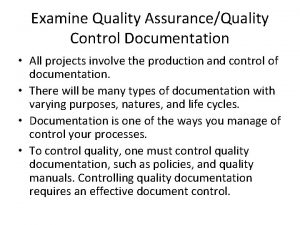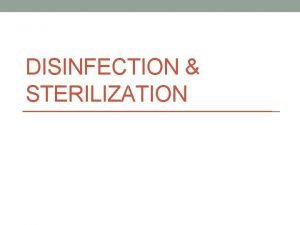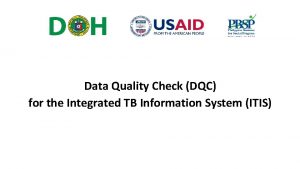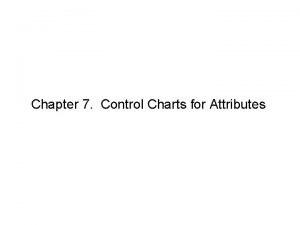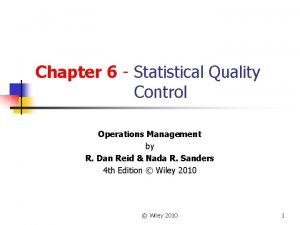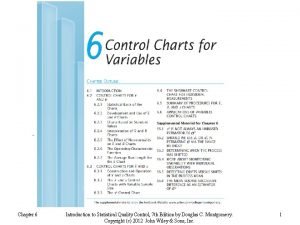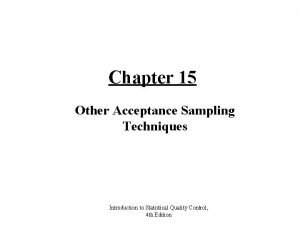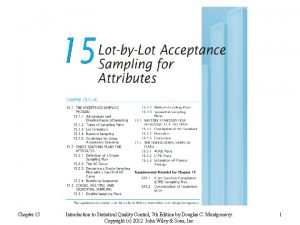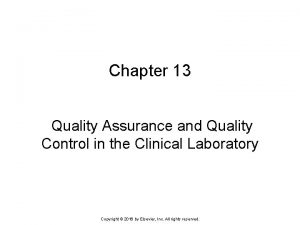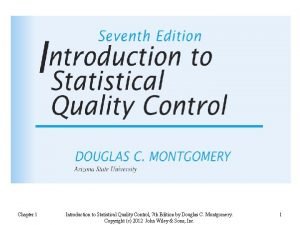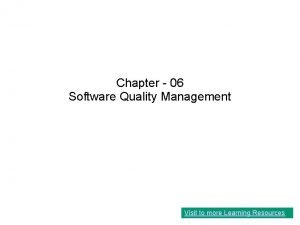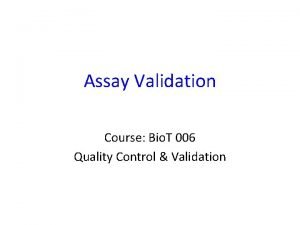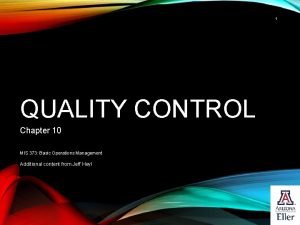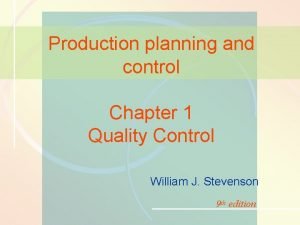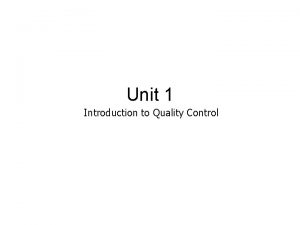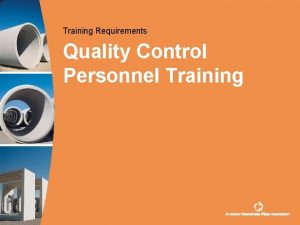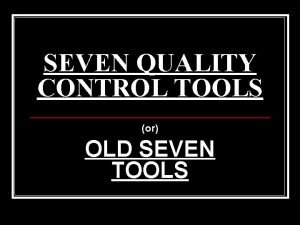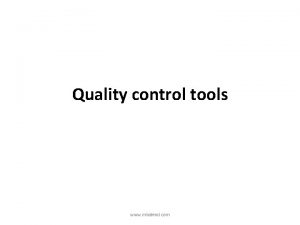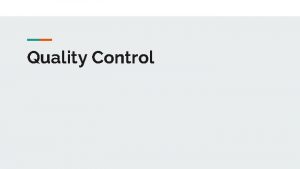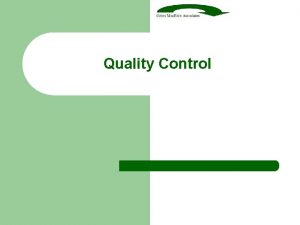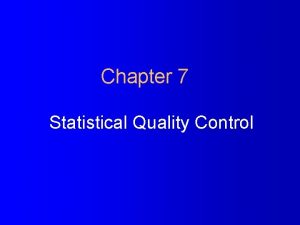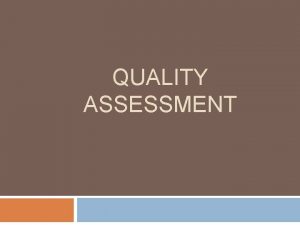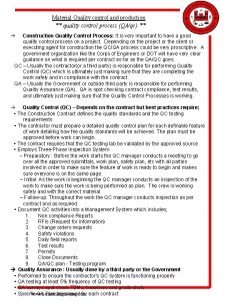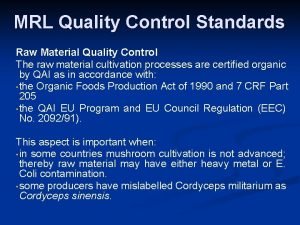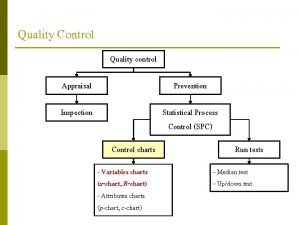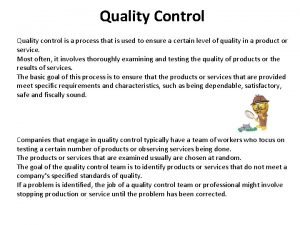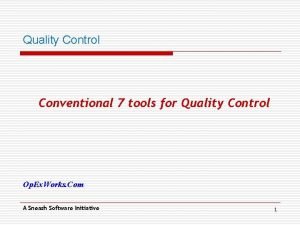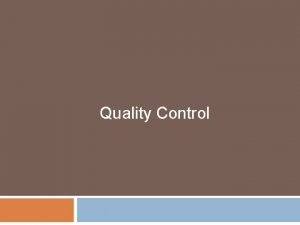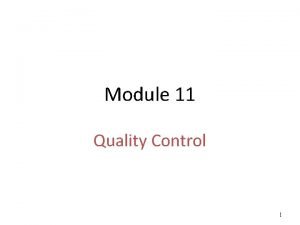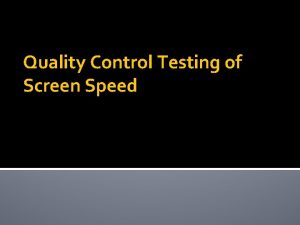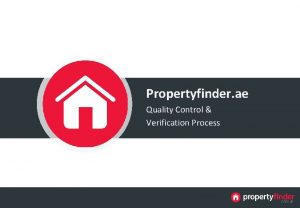Quality Control Agenda What is quality Approaches in





![Defining quality for producers. . Example: [Montgomery] - Real case study performed in ~1980 Defining quality for producers. . Example: [Montgomery] - Real case study performed in ~1980](https://slidetodoc.com/presentation_image_h/8433f838b79d4231f648a46be0e616ab/image-6.jpg)

![QC Approaches (1) Accept/Reject testing (2) Sampling (statistical QC) (3) Statistical Process Control [Shewhart] QC Approaches (1) Accept/Reject testing (2) Sampling (statistical QC) (3) Statistical Process Control [Shewhart]](https://slidetodoc.com/presentation_image_h/8433f838b79d4231f648a46be0e616ab/image-8.jpg)




























![X-bar charts: relationship between sample and x-bar [source: Montgomery] X-bar charts: relationship between sample and x-bar [source: Montgomery]](https://slidetodoc.com/presentation_image_h/8433f838b79d4231f648a46be0e616ab/image-37.jpg)













- Slides: 50

Quality Control Agenda - What is quality? - Approaches in quality control - Accept/Reject testing - Sampling (statistical QC) - Control Charts - Robust design methods

What is ‘Quality’ Performance: - A product that ‘performs better’ than others at same function Example: Sound quality of Apple i. Pod vs. i. River… - Number of features, user interface Examples: Tri-Band mobile phone vs. Dual-Band mobile phone Notebook cursor control (IBM joystick vs. touchpad)

What is ‘Quality’ Reliability: - A product that needs frequent repair has ‘poor quality’ Example: Consumer Reports surveyed the owners of > 1 million vehicles. To calculate predicted reliability for 2006 model-year vehicles, the magazine averaged overall reliability scores for the last three model years (two years for newer models) Best predicted reliability: Sporty cars/Convertibles Coupes Honda S 2000 Mazda MX-5 Miata (2005) Lexus SC 430 Chevrolet Monte Carlo (2005)

What is ‘Quality’ Durability: - A product that has longer expected service life Adidas Barricade 3 Men's Shoe (6 -Month outsole warranty) Nike Air Resolve Plus Mid Men’s Shoe (no warranty)

What is ‘Quality’ Aesthetics: - A product that is ‘better looking’ or ‘more appealing’ Examples? or ?
![Defining quality for producers Example Montgomery Real case study performed in 1980 Defining quality for producers. . Example: [Montgomery] - Real case study performed in ~1980](https://slidetodoc.com/presentation_image_h/8433f838b79d4231f648a46be0e616ab/image-6.jpg)
Defining quality for producers. . Example: [Montgomery] - Real case study performed in ~1980 for a US car manufacturer - Two suppliers of transmissions (gear-box) for same car model Supplier 1: Japanese; Supplier 2: USA - USA transmissions has 4 x service/repair costs than Japan transmissions Lower variability Lower failure rate Distribution of critical dimensions from transmissions

Definitions Quality is inversely proportional to variability Quality improvement is the reduction in variability of products/services. How to reduce in variability of products/services ?
![QC Approaches 1 AcceptReject testing 2 Sampling statistical QC 3 Statistical Process Control Shewhart QC Approaches (1) Accept/Reject testing (2) Sampling (statistical QC) (3) Statistical Process Control [Shewhart]](https://slidetodoc.com/presentation_image_h/8433f838b79d4231f648a46be0e616ab/image-8.jpg)
QC Approaches (1) Accept/Reject testing (2) Sampling (statistical QC) (3) Statistical Process Control [Shewhart] (4) Robust design methods (Design Of Experiments) [Taguchi]

Accept/Reject testing - Find the ‘characteristic’ that defines quality - Find a reliable, accurate method to measure it - Measure each item - All items outside the acceptance limits are scrapped Lower Specified Limit Upper Specified Limit target Measured characteristic

Problem with Accept/Reject testing (1) May not be possible to measure all data Examples: Performance of Air-conditioning system, measure temperature of room Pressure in soda can at 10° (2) May be too expensive to measure each sample Examples: Service time for customers at Mc. Donalds Defective surface on small metal screw-heads

Problems with Accept/Reject testing Solution: only measure a subset of all samples This approach is called: Statistical Quality Control What is statistics?

Background: Statistics Average value (mean) and spread (standard deviation) Given a list of n numbers, e. g. : 19, 21, 18, 20, 21, 20. Mean = m = S ai / n = (19+21+18+20+20+21+20+20) / 8 = 19. 875 The variance s 2 = The standard deviation = s = ≈ 0. 8594 = √( s 2) ≈ 0. 927.

Background: Statistics. . Example. Air-conditioning system cools the living room and bedroom to 20 ; Suppose now I want to know the average temperature in a room: - Measure the temperature at 5 different locations in each room. Living Room: 18, 19, 20, 21, 22. Bedroom: 19, 20, 20, 19. What is the average temperature in the living room? m = S ai / n = (18+19+20+21+22) / 5 = 20. BUT: is m = m ?

Background: Statistics. . . Example (continued) m = S ai / n = (18+19+20+21+22) / 5 = 20. BUT: is m = m ? If: sample points are selected randomly, thermometer is accurate, … then m is an unbiased estimator of m. - take many samples of 5 data points, - the mean of the set of m-values will approach m - how good is the estimate?

Background: Statistics. . Example. Air-conditioning system cools the living room and bedroom to 20 ; Suppose now I want to know the variation of temperature in a room: - Measure the temperature at 5 different locations in each room. Living Room: 18, 19, 20, 21, 22. ≈ 1. 4142 sn = BUT: is sn = s ? No! The unbiased estimator of stdev of a sample = s =

Sampling: Example Soda can production: Design spec: pressure of a sealed can 50 PSI at 10 C Testing: sample few randomly selected cans each hour Questions: How many should we test? Which cans should we select? To Answer: We need to know the distribution of pressure among all cans Problem: How can we know the distribution of pressure among all cans?

Sampling: Example. . How can we know the distribution of pressure among all cans? Plot a histogram showing %-cans with pressure in different ranges

Sampling: Example… Limit (as histogram step-size) 0: probability density function 30 35 40 45 55 50 pressure (psi) 60 65 70 pdf is (almost) the familiar bell-shaped Gaussian curve! why? True Gaussian curve: [-∞ , ∞]; pressure: [0, 95 psi]

Why is everything normal? pdf of many natural random variables ~ normal distribution WHY ? Central Limit Theorem Let X random variable, any pdf, mean, m, and variance, s 2 Let Sn = sum of n randomly selected values of X; As n ∞ Sn approaches normal distribution with mean = nm, and variance = ns 2.

Central limit theorem. . X 1 = -1, with probability 1/3 0, with probability 1/3 1, with probability 1/3 p(S 1) Example S 1 X 1 + X 2 -1 -1 -1 0 0 0 1 1 1 -1 0 1 -2 -1 0 1 0 1 2 X 1 + X 2 + X 3 = -3, -2, -1, 0, 1, 2, 3, X 1 + X 2 = with probability 1/27 with probability 3/27 with probability 6/27 with probability 7/27 with probability 6/27 with probability 3/27 with probability 1/27 -2, -1, 0, 1, 2, with probability 1/9 with probability 2/9 with probability 3/9 with probability 2/9 with probability 1/9 p(S 2) X 2 S 2 Curve joining p(S 3) -2 1 0 -1 2 Gaussian curve p(S 3) X 1 1 0 -1 S 3 -3 -2 -1 0 1 2 3

(Weaker) Central Limit Theorem. . . Let Sn = X 1 + X 2 + … + Xn Different pdf, same m and s normalized Sn is ~ normally distributed Another Weak CLT: Under some constraints, even if Xi are from different pdf’s, with different m and s, the normalized sum is nearly normal!

Central Limit Therem. . Observation: For many physical processes/objects variation is f( many independent factors) effect of each individual factor is relatively small Observation + CLT The variation of parameter(s) measuring the physical phenomenon will follow Gaussian pdf

Sampling for QC Soda Can Problem, recalled: How can we know the distribution of pressure among all cans? Answer: We can assume it is normally distributed Problem: But what is the m, s ? Answer: We will estimate these values Samples

Background: Scaling of Normal Distribution If x is N(m, s), then z = (x – m)/s is N( 0, 1) Standard Normal distribution tables

Normal Distribution scaling: example A manufacturer of long life milk estimates that the life of a carton of milk (i. e. before it goes bad) is normally distributed with a mean = 150 days, with a stdev = 14 days. What fraction of milk cartons would be expected to still be ok after 180 days? Z = 180 days (Z - m)/s = (180 - 150)/14 ≈ 2. 14 Use tables: Z = 2. 14 area = 0. 9838 Fraction of milk cartons that are ok Z ≥ 180 days or Z = m + 2. 14 s, is 1 - 0. 9838 = 0. 0162

Samples taken from a Normally Distributed Variable Central Limit Theorem Let X random variable, any pdf, mean, m, and variance, s 2 Let Sn = sum of n randomly selected values of X; As n ∞ Sn approaches normal distribution with mean = nm, and variance = ns 2. + Scaling Mean of the sample, m estimates mean of distribution Stdev of sample = s /√n. Estimates reliability of m as an estimate of m Standard error

Example: QC for raw materials A logistics company buys Shell-C brand diesel for its trucks. Full tank of fuel average truck travel ~ 510 Km, stdev 31 Km. New seller provides a cheaper fuel, Caltex-B, Claim that it will give similar mileage as the Shell-C. (i) What is the probability that the mean distance traveled over 40 full-tank journeys of Shell-C is between 500 Km and 520 Km? (ii) Mean distance covered by 40 full-tank journeys using Caltex-B ~ 495 Km. What is the probability that Caltex-B is equivalent to Shell-C?

Example: QC for raw materials. . (i) Shell-C: Full tank of fuel m ~ 510 Km, s ~ 31 Km. P( mean distance)40 is in [500 Km, 520 Km] ? Mean distance ≈ N( 510, s/√ 40 ) = N( 510, 31/√ 40 ) ≈ N( 510, 4. 9) Use tables, Area between: z= (500 -510)/4. 9 ≈ -2. 04 and z = (520 - 510)/4. 9 ≈ 2. 04 Area = 1 - (( 1 - 0. 9793) + (1 - 0. 9793)) = 0. 9586 P( mean distance)40 [500 Km, 520 Km] = 95. 86%

Example: QC for raw materials. . . (ii) Shell-C: Full tank of fuel m ~ 510 Km, s ~ 31 Km. Mean distance covered by 40 full-tank journeys using Caltex-B ~ 495 Km. What is the probability that Caltex-B is equivalent to Shell-C? P(mean distance over 40 journeys) ≤ 495 ? m= 495 z = (495 - 510)/4. 9 ≈ -3. 06 P( m 40 using Shell-C or similar ≥ 495) = 0. 9989 P(Caltex-B is equivalent to Shell-C) = (1 - 0. 9989) = 0. 0011 This method of reasoning is related to Hypothesis Testing

Summary/Comments on Sampling - Statistics provides basis for reasoning; - Sampling is economical and more efficient than accept/reject - We may not know the population m and/or s more complex reasoning (not covered in this course)

Control Charts in QC 1. Use sampling of product/process 2. Repeat sampling at regular intervals 3. Plot the time series data 4. Look for any ‘patterns’ that may indicate ‘out-of-control’ process 4. 1. Look for problem 4. 2. Solve problem bring process back to ‘under-control’

Process Control Charts: example Piston rings manufacturing Critical dimension: inside diameter Mfg process designed for: mean diameter = 74 mm, s = 0. 01 mm Measure random sample of 5 rings in each hour Record mean value of the inside diameter Plot

Process Control Charts example: X-bar charts Mfg process designed for: mean diameter = 74 mm, s = 0. 01 mm [source: Montgomery]

X-bar charts – UCL and LCL s = 0. 01, and n = 5; is normally distributed with s = 0. 01/√ 5 = 0. 0045 Process is in-control We should avoid a “False rejection” m lies in acceptance interval Accept the claim No error m lies in the rejection interval Type II error a = P( Type I error) Reject the claim Type I error No error

X-bar charts – UCL and LCL. . Process is in-control We should avoid a “False rejection” m lies in acceptance interval m lies in the rejection interval Accept the claim No error Type II error Reject the claim Type I error No error If we never reject the claim never commit Type I error a = P( Type I error) 100(1 - a)% of the sample m must lie in [ 74 - Za/2(0. 0045), 74 + Za/2(0. 0045)] is N( 74, 0. 0045) Typical: P( Type I error) < 0. 0027 Za/2 = 3

X-bar charts – UCL and LCL. . . Avoid “False rejection” P( Type I error) < 0. 0027 Za/2 = 3 3 -sigma control limits Piston Rings: Control limits = 74 ± 3(0. 0045) UCL = 74. 0135, LCL = 73. 9865 [source: Montgomery]
![Xbar charts relationship between sample and xbar source Montgomery X-bar charts: relationship between sample and x-bar [source: Montgomery]](https://slidetodoc.com/presentation_image_h/8433f838b79d4231f648a46be0e616ab/image-37.jpg)
X-bar charts: relationship between sample and x-bar [source: Montgomery]

Points of interest -- larger sample size control limit lines move close together -- Larger sample size control chart can identify smaller shifts in the process -- ± 2 s warning lines [source: Montgomery+]

Using Control Charts Observation Possible Cause One or more points outside of the control limits A special cause of variance due to material, equipment, method or measurement system change Error in measurement of part(s) Error in plotting (or calculating point) Error in plotting/calculating limits Run of eight points on one side of the center line Shift in the process output due to changes in the equipment, methods, or materials Shift in the measurement system

Using Control Charts. . Observation Possible Cause Two of three consecutive points outside the 2 -sigma warning limits but still inside the control limits Large shift in the process in the equipment, methods, materials, or operator Shift in the measurement system Four of five consecutive points beyond the 1 -sigma limits -same- Trend of seven points in a row upward or Deterioration/wear of equipment Improvement/Deterioration of technique downward Cycling of data Temperature or recurring changes Operator/Operating differences Regular rotation of machines Difference in measuring devices used in rotation

Process Control Charts… - Great practical use in factories - First introduced by Walter A. Shewhart - Help to reduce variability - Monitor performance over time - Trends and out-of-control are immediately detected - Other common control charts: Range-charts (R-charts), …

Robust Design and Taguchi Methods Example: The INA Tile Company - Tiles made in Kiln - Variability in size too high - Variation due to baking process - Accept/Reject is expensive!

Ina Tile Example. . Cause: Different temperature profile in different regions SPC approach: Eliminate cause redesign Kiln

Ina Tile Example. . . Cause: Different temperature profile in different regions SPC approach: Eliminate cause reduce Temp variation How ? redesign Kiln Expensive!

Ina Tile example: Taguchi Method Response: Tile dimension Control Parameters (tile design): Amount of Limestone Fineness of additive Amount of Agalmatolite Type of Agalmatolite Raw material Charging Quantity Amount of Waste Return Amount of Feldspar Noise parameter was the temperature gradient. Taguchi: Experiment with different values of Control Parameters!

Ina Tile example: Taguchi Method. . Experiment with different values of Control Parameters Higher Limestone content desensitize design to noise

Robust Design definition A method of designing a process or product aimed at reducing the variability (deviations from target performance) by lowering sensitivity to noise. HOW ?

Design of Experiments

Typical Objectives of DOE (i) Determine which input variables have the most influence on the output; (ii) Determine what value of xi’s will lead us closest to our desired value of y; (iii) Determine where to set the most influential xi’s so as to reduce the variability of y; (iv) Determine where to set the most influential xi’s such that the effects of the uncontrollable variables (zi’s) are minimized. Tool used: ANalysis Of VAriance ANOVA

Concluding Remarks Statistical Tools are critical to QC QC is critical to all productive activities next topic: review for exam!
 Agenda sistemica y agenda institucional
Agenda sistemica y agenda institucional Quality control and quality assurance
Quality control and quality assurance Plan quality management pmp
Plan quality management pmp Pmp gold plating
Pmp gold plating Basic concept of quality management
Basic concept of quality management Introduction to tqm
Introduction to tqm Define seminar in nursing management
Define seminar in nursing management Compliance vs quality
Compliance vs quality Gurus of tqm
Gurus of tqm Crosby's fourteen steps to quality improvement
Crosby's fourteen steps to quality improvement Old quality vs new quality
Old quality vs new quality Ipc quality control
Ipc quality control Contoh tqc
Contoh tqc What is sampling plan in quality control
What is sampling plan in quality control Average run length in quality control
Average run length in quality control Variables and attributes in quality control
Variables and attributes in quality control Software quality assurance plans
Software quality assurance plans Quality control log examples
Quality control log examples Subway quality control
Subway quality control Seismic quality control
Seismic quality control Quality control business plan
Quality control business plan Control determination
Control determination Raw material control
Raw material control External quality control examples
External quality control examples Quality control of fresh fruits and vegetables
Quality control of fresh fruits and vegetables Brewery quality control
Brewery quality control Quality control in hematology wikipedia
Quality control in hematology wikipedia Site:slidetodoc.com
Site:slidetodoc.com Quality test for parenterals
Quality test for parenterals What is a quality control
What is a quality control Function of tqm
Function of tqm Quality control documentation
Quality control documentation Chemical indicator for system 1e
Chemical indicator for system 1e Dqc data quality control
Dqc data quality control Control chart for nonconformities
Control chart for nonconformities What is sqc in operations management
What is sqc in operations management Average run length in quality control
Average run length in quality control What is sampling plan in quality control
What is sampling plan in quality control What is sampling plan in quality control
What is sampling plan in quality control Levey jennings chart
Levey jennings chart Introduction to statistical quality control montgomery
Introduction to statistical quality control montgomery A key concept of quality control is that all work products
A key concept of quality control is that all work products Quality control assay
Quality control assay Operations management chapter 10 quality control solutions
Operations management chapter 10 quality control solutions Qc meaning
Qc meaning Introduction to quality control
Introduction to quality control Qc personnel
Qc personnel Aec quality control
Aec quality control 7 quality control tools
7 quality control tools Quality control approved by rf
Quality control approved by rf Quality control process flow chart
Quality control process flow chart





